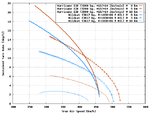claidemore
Senior Airman
I believe the 8 x .303 Brownings would fire 160 rds per second (20 rds a second or 1150/1200 rds/min per gun) giving a Hurricane a firing time of 17.5 seconds, five/six - 3 seconds bursts. A 12 gun Hurricane IIb would fire 240 rds/second.
4 x .50 at 750-850 rpm would give 50-56 rds per second.
Also, I'd like to point out, that the pilots flying these planes were aware of the convergence problem, and at extremely short ranges, they were known to bring to bear the guns of one wing only, to make sure the enemy plane didn't fly harmlessless throught the 'hole'.
4 x .50 at 750-850 rpm would give 50-56 rds per second.
Also, I'd like to point out, that the pilots flying these planes were aware of the convergence problem, and at extremely short ranges, they were known to bring to bear the guns of one wing only, to make sure the enemy plane didn't fly harmlessless throught the 'hole'.

